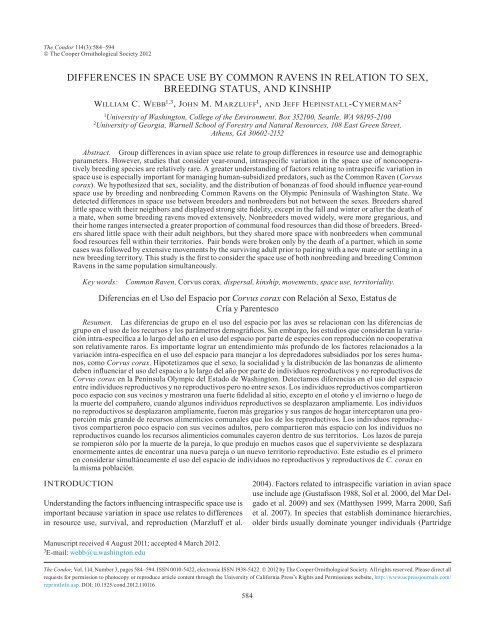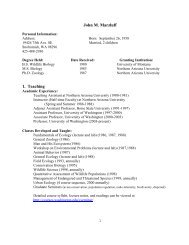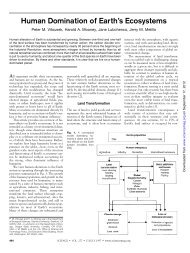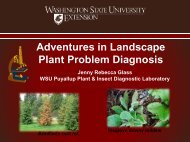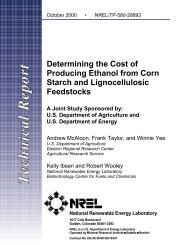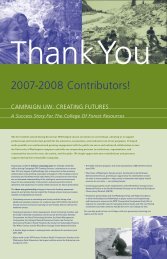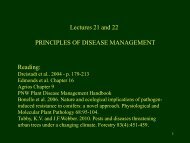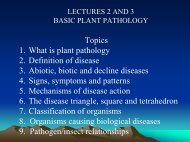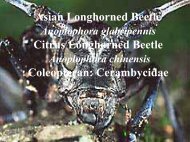DIFFERENCES IN SPACE USE by COMMON RAVENS IN ...
DIFFERENCES IN SPACE USE by COMMON RAVENS IN ...
DIFFERENCES IN SPACE USE by COMMON RAVENS IN ...
- No tags were found...
You also want an ePaper? Increase the reach of your titles
YUMPU automatically turns print PDFs into web optimized ePapers that Google loves.
The Condor 114(3):584–594© The Cooper Ornithological Society 2012Differences in Space Use <strong>by</strong> Common Ravens in Relation to Sex,Breeding Status, and KinshipWilliam C. Webb 1,3 , John M. Marzluff 1 , and Jeff Hepinstall-Cymerman 21University of Washington, College of the Environment, Box 352100, Seattle, WA 98195-21002University of Georgia, Warnell School of Forestry and Natural Resources, 108 East Green Street,Athens, GA 30602-2152Abstract. Group differences in avian space use relate to group differences in resource use and demographicparameters. However, studies that consider year-round, intraspecific variation in the space use of noncooperativelybreeding species are relatively rare. A greater understanding of factors relating to intraspecific variation inspace use is especially important for managing human-subsidized predators, such as the Common Raven (Corvuscorax). We hypothesized that sex, sociality, and the distribution of bonanzas of food should influence year-roundspace use <strong>by</strong> breeding and nonbreeding Common Ravens on the Olympic Peninsula of Washington State. Wedetected differences in space use between breeders and nonbreeders but not between the sexes. Breeders sharedlittle space with their neighbors and displayed strong site fidelity, except in the fall and winter or after the death ofa mate, when some breeding ravens moved extensively. Nonbreeders moved widely, were more gregarious, andtheir home ranges intersected a greater proportion of communal food resources than did those of breeders. Breedersshared little space with their adult neighbors, but they shared more space with nonbreeders when communalfood resources fell within their territories. Pair bonds were broken only <strong>by</strong> the death of a partner, which in somecases was followed <strong>by</strong> extensive movements <strong>by</strong> the surviving adult prior to pairing with a new mate or settling in anew breeding territory. This study is the first to consider the space use of both nonbreeding and breeding CommonRavens in the same population simultaneously.Key words: Common Raven, Corvus corax, dispersal, kinship, movements, space use, territoriality.Diferencias en el Uso del Espacio por Corvus corax con Relación al Sexo, Estatus deCría y ParentescoResumen. Las diferencias de grupo en el uso del espacio por las aves se relacionan con las diferencias degrupo en el uso de los recursos y los parámetros demográficos. Sin embargo, los estudios que consideran la variaciónintra-específica a lo largo del año en el uso del espacio por parte de especies con reproducción no cooperativason relativamente raros. Es importante lograr un entendimiento más profundo de los factores relacionados a lavariación intra-específica en el uso del espacio para manejar a los depredadores subsidiados por los seres humanos,como Corvus corax. Hipotetizamos que el sexo, la socialidad y la distribución de las bonanzas de alimentodeben influenciar el uso del espacio a lo largo del año por parte de individuos reproductivos y no reproductivos deCorvus corax en la Península Olympic del Estado de Washington. Detectamos diferencias en el uso del espacioentre individuos reproductivos y no reproductivos pero no entre sexos. Los individuos reproductivos compartieronpoco espacio con sus vecinos y mostraron una fuerte fidelidad al sitio, excepto en el otoño y el invierno o luego dela muerte del compañero, cuando algunos individuos reproductivos se desplazaron ampliamente. Los individuosno reproductivos se desplazaron ampliamente, fueron más gregarios y sus rangos de hogar interceptaron una proporciónmás grande de recursos alimenticios comunales que los de los reproductivos. Los individuos reproductivoscompartieron poco espacio con sus vecinos adultos, pero compartieron más espacio con los individuos noreproductivos cuando los recursos alimenticios comunales cayeron dentro de sus territorios. Los lazos de parejase rompieron sólo por la muerte de la pareja, lo que produjo en muchos casos que el superviviente se desplazaraenormemente antes de encontrar una nueva pareja o un nuevo territorio reproductivo. Este estudio es el primeroen considerar simultáneamente el uso del espacio de individuos no reproductivos y reproductivos de C. corax enla misma población.<strong>IN</strong>TRODUCTIONUnderstanding the factors influencing intraspecific space use isimportant because variation in space use relates to differencesin resource use, survival, and reproduction (Marzluff et al.2004). Factors related to intraspecific variation in avian spaceuse include age (Gustafsson 1988, Sol et al. 2000, del Mar Delgadoet al. 2009) and sex (Matthysen 1999, Marra 2000, Safiet al. 2007). In species that establish dominance hierarchies,older birds usually dominate younger individuals (PartridgeManuscript received 4 August 2011; accepted 4 March 2012.3E-mail: webb@u.washington.eduThe Condor, Vol. 114, Number 3, pages 584–594. ISSN 0010-5422, electronic ISSN 1938-5422. © 2012 <strong>by</strong> The Cooper Ornithological Society. All rights reserved. Please direct allrequests for permission to photocopy or reproduce article content through the University of California Press’s Rights and Permissions website, http://www.ucpressjournals.com/reprintInfo.asp. DOI: 10.1525/cond.2012.110116584
586 William C. Webb et al.FIGURE 1. Map of the study site on the Olympic Peninsula of Washington State. Population centers include the cities of Port Angeles(population 18 982) and Sequim (5809) and the town of Forks (3120). Smaller population centers include the communities of Neah Bay(population 794), Beaver (633), and La Push (350).consistently renewed food sources and are known as point subsidies(Webb et al. 2009).Capture and markingBetween December 2002 and August 2005, we captured 60ravens (22 juveniles 35 adults, and 3 subadults) with a remotecontrolledportable net launcher (Coda Enterprises, Ltd.). Wemeasured and color-banded each raven with a unique combinationof plastic color bands and an aluminum U.S. Fish and WildlifeService band. Each raven was outfitted with a backpack-mountedradio transmitter (Buehler et al. 1995) weighing 27 g (AdvancedTelemetry Systems, Isanti, MN) with a projected lifespan of40 months. We used a combination of plumage, mouth lining,and breeding behavior (Pyle et al. 1997, Heinrich and Marzluff1992) to classify the age and breeding status of trapped ravens.Juveniles were birds of known age that had fledged fromand were trapped within known territories during the breedingseasons of 2003 (6 juveniles), 2004 (7 juveniles), or 2005(9 juveniles). Subadults were unpaired individuals of breedingage, as indicated <strong>by</strong> black mouth color (Heinrich and Marzluff1992). Breeders were trapped in their territories, and subadultswere trapped opportunistically during efforts focused on trappingbreeders and their offspring. Since juveniles and subadults rangesimilarly (Heinrich et al. 1994), we pooled these two nonbreedinggroups for statistical analyses. We used molecular techniques tosex the birds, sampling two small growing feathers from each individualand using a PCR reaction that amplifies the CHD genefragments on the W and Z chromosomes (Griffiths et al. 1998).Radio telemetryWe tracked ravens continuously from May 2003 to March 2007(47 consecutive months) with an ATS R2000 portable scanningradio receiver (ATS, Isanti, MN, USA) attached to 4-elementYagi antennas on a truck and 2- and 3-element Yagi antennasheld <strong>by</strong> hand, On one occasion during the middle of the studyin May 2005, to search for missing birds within 200 km of theperimeter of the study, we used dual wing-mounted 3-elementYagi antennas attached to an airplane. During the spring andsummer (March–September), we tracked ravens several timesper month, during the rest of the year, for one week per month,until each bird died or its transmitter stopped functioning(mean 2.44, range 0.77–5.11 locations month –1 ). We followedtwo surviving juveniles and one subadult from the 2003 cohortwith functioning transmitters into their fifth year, and threejuveniles from the 2004 cohort into their fourth year, and threejuveniles from the 2005 cohorts into their third year.We used homing techniques (White and Garrot 1990) andtriangulation to estimate ravens’ locations (no more than once per
Raven Space Use 587bird per 24 hr; Otis and White 1999). Typically we saw the taggedbird and recorded its location with a hand-held GPS unit. Whenthis was not possible because of dense vegetation or the remotenessof parts of the study area, we triangulated (199 locations, or6% of the total). We based estimates <strong>by</strong> triangulation on at leastthree compass bearings forming angles of 45–110°, obtainedwithin 5 min of each other. Telemetry locations and error polygonswere generated with LOCATE II (Nams 1990), and locations witherror polygons >2.0 ha (a circular area with radius 80 m) wereomitted. The detectability of transmitter signals ranged from1 to 50 km, depending upon the search mode (vehicle, foot, oraircraft), topography, and behavior of the individual birds. Twiceannually (once in the spring and fall) we used vehicle-based radioreceivingequipment to search extensively outside the study site <strong>by</strong>driving up to 150 km beyond its perimeter.We used vocal and visual cues to estimate the abundanceof conspecifics within a 100-m radius of each radio-taggedbird. We verified distance radii for abundance estimates in thefield with a hand-held GPS unit. On the basis of consistentlyhigh raven abundance at locations providing the birds dependablesources of food, we identified eight communal pointsubsidies within the study area: three livestock ranches, twowaste facilities, one hob<strong>by</strong> farm, a fish hatchery, and a prison.To compare the relative importance of point subsidies forbreeders and nonbreeders, we quantified the volume of intersectionof the home ranges of breeders and nonbreeders with a500-m buffer around each communal point subsidy.Space-use analysesAn important measure of avian space use is the home range. Weestimated ravens’ home ranges as the two-dimensional extent oftheir three-dimensional utilization distributions (UDs) on the basisof point locations in ArcGIS 9.2 with the Home Range Tools(HRT) for ArcGIS 9.x (Rodgers et al. 2005) <strong>by</strong> implementing a99% fixed-kernel estimator (Seaman et al. 1999). We estimatedhome ranges for ravens with 10 or more locations and for juvenileravens with 10 or more locations of dispersal outside the natalterritory. Consistent with previous findings with this species(Webb et al. 2009), we established that this definition of adequatesample size was sufficient to quantify relative differences in spaceuse (Garton et al. 2001) <strong>by</strong> determining that there was no positivecorrelation between sample size and home range (R 2 = 0.01,P = 0.49) (Webb et al. 2011a). Using an objective criterion thatminimizes the risk for oversmoothing or undersmoothing (Worton1989, Sain et al. 1994), we selected the smoothing parameter<strong>by</strong> first buffering each location <strong>by</strong> 625 m. This scale relates to datacollection (the square of the minimum resolution of spatial data,25 m), forest management, and reflects a priori distances thoughtrelevant to ravens’ behavior and their sensory abilities. We thengenerated provisional home ranges with different proportions ofHREF until the provisional home range with a continuous outerisopleth closely approximated the 625-m buffer around the largestgrouping of locations for each individual. We chose the smoothingparameter based on the proportion of href associated withthe closest-matching provisional UDs. We generated individualhome ranges for each raven and separate sets of group homeranges for breeders and nonbreeders. We calculated a group homerange for each individual (the focal individual) <strong>by</strong> using locationsfor all members of the group (breeding or nonbreeding) except thefocal individual. We used a two-factor ANOVA to compare averagehome range area across all years between birds of differentsex, different breeding status, and their interaction.In a tagged population, the distances birds move betweenlocations where they are radio-tracked represent anotherimportant aspect of their space use. Therefore, in additionto quantifying home ranges, we measured three indices ofbreeders’ and nonbreeders’ movement, including the median,initial, and maximum distance ravens were located fromthe location where they were initially trapped. We defined abreeder’s extraterritorial movements as any movement fartherfrom the location of initial trapping than the diameter of thelargest contiguous isopleth of its home range.Statistical analysesUsing two-factor ANOVAs for breeders and nonbreeders (subadultswith >10 locations and juveniles with >10 post-dispersallocations), we compared movement indices <strong>by</strong> sex and breedingstatus, as well as their interaction. We defined natal dispersal asthe movements of juvenile ravens between their natal territoryand first breeding territory (Greenwood 1980). Although thereare few records of their natal dispersal, most ravens probablydo not breed until their fourth year or later (Webb 2010). Therefore,we defined juvenile dispersal as the subset of movementsjuvenile ravens made outside their natal territory prior to nataldispersal. We defined a juvenile’s initial movement distance asits first dispersal location outside its natal territory. Based uponobservations of territorial behavior of breeders, this area usuallyextended 0.5 to 1.0 km from the nest. We restricted ouranalyses of space use between relatives to known relationshipsbetween juveniles, broodmates, and their parents established <strong>by</strong>observing reproductive behavior.Since our study was much shorter than the lifespan of manyravens, and we were unable to radio-tag every individual withineach family group, our knowledge of family relationships betweenbirds was incomplete. We assumed that all known parent–offspring relationships were genetic since extra-pair copulation israre among ravens (Boarman and Heinrich 1999), and we did notobserve evidence of this behavior. To characterize the durationof the bonds between adults and their offspring, we also investigatedthe degree of post-dispersal association between juveniles,broodmates, and their parents <strong>by</strong> quantifying the frequency andtiming of locations recorded inside the natal territory after initialdispersal from the natal territory.The amount of space conspecifics share is an important characteristicof space use and provides insight into social behavior. Wequantified space-sharing <strong>by</strong> ravens <strong>by</strong> the index statistic volume ofintersection (VI) (Seidel 1992, Kernohan et al. 2001). The VI indexdetermines the proportion of an animal’s UD which is shared, and
588 William C. Webb et al.ranges from 0 for no overlap to 1 for complete overlap. In calculatingVI, we analyzed data for each year separately. We estimatedthe VI between adult ravens occupying neighboring territories toquantify the extent of space sharing <strong>by</strong> neighboring territory holders.To characterize the degree of association between nonbreedersand adults, we compared the VI that individual nonbreeders andindividual breeders shared with the population of nonbreeders. Todetermine whether broodmates preferentially associate, we comparedthe VI shared <strong>by</strong> broodmates to the VI shared between thosesame birds and the rest of the unrelated nonbreeding population.We defined neighbors as any pair of unrelated breeders withtheir largest contiguous isopleths ≤625 m apart, a quantity relatedto the spatial scale of analysis, and also too narrow for anintervening third pair’s home range. Although most breeding ravens’home ranges (n = 34) lay near at least one neighbor (range0–7), the density of tagged neighbors numbered less than thegeometrical hypothetical maximum of 12 neighbors from 6 adjacentterritories (assuming roughly hexagonal territories, Wilson1975:272). We estimated the VI shared <strong>by</strong> neighboring breedingravens <strong>by</strong> regressing the mean number of neighboring breedingravens for each breeding raven across years with the mean VIwith the home range from the population of unrelated breedingravens across years.Unless otherwise indicated, we used SPSS (SPSS 2004)for our analyses. We applied P < 0.05 as the significance levelalong with two-tailed tests. We checked for normality withthe Kolmogorov–Smirnov goodness-of-fit test, and tested forhomogeneity of variance with Levene’s test. To meet the assumptionsof general linear models, we used arcsin or naturallog transformations in all parametric analyses. For all analyses,we pooled subadults with juveniles into the class of nonbreeders.We analyzed data for an individual separately if itmoved to a new territory or transitioned to a new breeding status.The values reported under Results are means ± SD.RESULTSResults of radio trackingWe obtained 3215 locations <strong>by</strong> radio-tracking ravens fromFebruary 2003 until June 2007 (Table 1). Four juveniles perishedbefore we obtained 10 locations outside their natal territories,and another disappeared before the sample reached 10, so we excludedthese 5 individuals from relevant analyses. Of these 60birds (including 4 analyzed separately after they moved to a newterritory or transitioned to a new breeding status) we recorded1–9 locations for 5, 10–29 locations for 12, 30–49 locations for17, 50–69 locations for 20, and ≥70 locations for 10. The lengthof time that individual birds were followed after they were radiotaggedranged from 67 to 1455 days (678 ± 365 days).Fate of tagged ravensThrough the end of the study, 25 ravens died, 4 disappeared,2 dropped their transmitters while still alive, 10 transmitterbatteries died while the birds were still alive, and 19 remainedalive with functioning transmitters. No individuals were knownto have left the study area. Aside from 9 deaths of unknowncause, the causes of mortality and their frequency included predation<strong>by</strong> owl or raptor (7), shooting (6), broken wing (1), crushed<strong>by</strong> falling tree (1), and entangling of the transmitter harness in atree canopy (1) . Given breeders’ strong site fidelity, at least threecases of disappearance were likely shootings that also destroyedthe transmitters and precluded recovery of the carcass.We radio-tagged both members of 15 mated pairs, andamong 8 of these, one member (3 males, 5 females) perishedprior to its mate. All 5 males remated <strong>by</strong> the following breedingseason and remained in the same territory, although one maletemporarily moved extensively, as expected for a nonbreeder(located 7.2–20.2 km outside his territory), between Octoberand February near the time of his mate’s death in December2005. He could not be found in March but reappeared back inhis territory in April 2006 with a new mate. Two of the femalesremated <strong>by</strong> the breeding season following the deaths of theirmates; one remained on the same territory, while the othersettled in an adjacent territory after a brief period of extensivemovements that lasted 5 weeks, during which she was locatedup to 16 km from the location of her initial trapping (Fig. 2).After her mate perished in August 2005, the third female lefther territory in which she had fledged four offspring earlier thatTABLE 1. Locations of radio-tracking of breeding and nonbreedingCommon Ravens on the Olympic Peninsula <strong>by</strong> year and season.Year and season aLocations(n)Unique ravenslocated (n)Mean and SD2003Spring 32 9 3.56 ± 3.00Summer 273 20 13.65 ± 5.87Fall 115 19 6.05 ± 1.902004Winter 55 11 3.73 ± 0.65Spring 193 20 9.65 ± 6.59Summer 343 34 10.06 ± 6.95Fall 116 29 4.00 ± 1.392005Winter 101 30 3.37 ± 1.38Spring 449 45 9.98 ± 8.07Summer 455 50 9.10 ± 4.69Fall 162 41 3.95 ± 1.702006Winter 107 35 3.06 ± 1.41Spring 350 37 9.49 ± 5.06Summer 280 29 10.00 ± 6.42Fall 99 28 3.54 ± 1.452007Winter 83 25 3.32 ± 1.18Spring 12 10 1.50 ± 0.71aWinter, January–March; spring, April–June; summer, July–September; fall, October–December.
Raven Space Use 589FIGURE 2. Locations of radio tracking and extent of home range (99% outer isopleth) of a breeding female Common Raven (Q6) trappedin April 2005 and followed until the end of the study in March 2007. This bird used home range 1 until her mate was shot in June 2006. Afterher mate’s death, Q6 appeared to wander outside home range 1 (represented <strong>by</strong> dark straight lines) until settling in home range 2 with a newmate in August 2006. During the subsequent fall, Q6 was located on several occasions attending two separate food bonanzas several kilometersfrom the core of her territory (curved arrows). In both cases the food bonanzas were slaughtered cow carcasses that attracted severaldozen ravens, including some that were radio-tagged.season and did not breed through the end of the study, while twountagged breeders took residence in her former territory.Juvenile and natal dispersalAll 22 radio-tagged juveniles survived dispersal from their natalterritory, although we did not obtain an accurate radio locationfor one of these until after it had died. We briefly detected a radiosignal from this juvenile in August 2005 ~10 km south of the natalterritory, which indicated the bird was flying rapidly, preventingrecording of a reliable location. The signal for this juvenile wasnot detected again until May 2006 when we recovered its carcass48.6 km from the nest. The mean date when juveniles were firstobserved outside their natal territories, 2003–2005, was 9 August(n = 21), range 9 July–25 September. Of 17 juveniles with radiotaggedfamily members, in six cases a broodmate accompaniedthe dispersing juvenile, and in one case a breeding raven was withits offspring at the juvenile’s first dispersal location. Once locatedoutside the natal territory, most (16/22) juveniles did not return totheir natal territories. The other six juveniles were sighted withintheir natal territory off and on for an additional period (range5–26 days) after their initial dispersal.Following independence, most (12/22) juveniles werelocated at least once inside their parents’ home ranges (95%UD), but only as members of a large group attracted to communalresources—food bonanzas or point subsidies. Onemale juvenile that fledged in 2003 was located the majorityof the time (83% of all locations) within his parents’ homeranges, which also encompassed a point subsidy. The meanpopulation frequency of juveniles’ post-dispersal locationsinside the natal territory was generally low (0.08 ± 0.17, range0–0.83). A male trapped as a juvenile in 2003 bred unsuccessfullyin his fourth year but fledged two young in his fifth yearin a territory 4.9 km from his natal territory where his fatherstill resided. Another bird trapped in 2003, a female subadultof unknown age, fledged one young after 3 years in a territory11.7 km from the location where she was trapped.Home ranges and site fidelityThe median distance of movement from the location of initialtrapping was 0.9 km for breeders (range 0.3–2.5 km), and9.9 km for nonbreeders (range 1.4–63.4 km, Table 2). Distancesmoved <strong>by</strong> nonbreeders were significantly greater than those
590 William C. Webb et al.TABLE 2. Movement metrics for adult and nonbreeding ravens with >10 locations recorded on the Olympic Peninsula. Ofthe 60 ravens radio-tagged, five juveniles perished before we obtained 10 locations outside the natal territory. Data from fourravens were analyzed separately after these birds moved to new territories or transitioned between social classes. All values aremeans except for movement distance, which is the median.♂ (n = 30) ♀( n = 29)Adults(n = 38)Nonbreeders(n = 21)Movement metric x SE x SE F P x SE x SE F PHome range (ha) 1534 206 1275 212 0.11 0.74 859 176 1950 237 39.44
Raven Space Use 591FIGURE 3. A portion of the study site depicting volume of intersections (VI) of utilization distributions (UD) of breeding CommonRavens with adjacent home ranges. Within a UD, taller-appearing portions represent regions of greater use.nonbreeders wandering hundreds of kilometers (Bruggers1988, Heinrich et al. 1994, Restani et al. 2001). Potential explanationsfor these differences in nonbreeders’ philopatry mightinclude geography, relative harshness of climate, seasonalmigration patterns, and the relative abundance of point subsidies.For example, ravens in the Arctic and Greenland migrateseasonally (Restani et al. 2001), and ravens breeding inthe Mojave Desert appear to relax their territoriality outside thebreeding season (Webb et al. 2009). The philopatry of juvenileravens on the Olympic Peninsula and in the western MojaveDesert is probably influenced in large part <strong>by</strong> geographic barriers.Our study area on the Olympic Peninsula is surrounded<strong>by</strong> the Pacific Ocean to the west, the Strait of Juan de Fuca tothe north, and the Olympic Mountains to the east. The westernMojave Desert study area (Webb et al. 2009) is surrounded <strong>by</strong>three large mountain ranges to the north and west and relativelyinhospitable open desert to the south and east. Differences inthe density of point subsidies could also explain the apparent inconsistenciesin nonbreeders’ vagility reported in the scientificliterature. Although those authors did not report on the densityof point subsidies, it is likely that their study sites in Minnesota(Bruggers at al 1988), New England (Heinrich et al. 1994),and Greenland (Restani et al. 2001) were characterized a lowerdensity of point subsidies than existed on the Olympic Peninsulaor in the western Mojave Desert (Webb et al. 2009). A highdensity of point subsidies in the western Mojave Desert and theOlympic Peninsula might preclude the need for nonbreeders tosearch for less abundant natural but ephemeral food bonanzasscattered over much larger areas.Territoriality and space useAvian territories cover a spectrum ranging from completeoverlap with no apparent defense to exclusive domains withclearly defined, well-defended boundaries (Newton 1998). Onthe Olympic Peninsula, breeding ravens shared a high degreeof space with their own mates, but they shared very little spacewith their breeding neighbors. Because food bonanzas attractedlarge numbers of nonbreeders, some breeders sharedmore space with the population of nonbreeders than theyshared with their breeding neighbors. Some breeding ravens’territories encompassed point subsidies, at which radiotaggednonbreeders were almost always present. Breedingravens’ UDs containing neither point subsidies nor food bonanzasdid not attract unrelated radio-tagged nonbreeders.Breeding ravens’ sharing space with the population of nonbreedersreinforces previous findings (Marzluff and Heinrich1991) that nonbreeders gain access to resources through theirnumerical advantage rather than their competitive abilities.Low space sharing <strong>by</strong> neighboring breeding ravens suggestedthat breeders maintained relatively sharp territorial
592 William C. Webb et al.boundaries. One advantage to territoriality is priority accessto resources (Newton 1998, Sunde and Bolstad 2004), and forravens on the Olympic Peninsula, territoriality confers not onlythe opportunity to breed but also greater access to those resourcesassociated with higher survivorship (Webb et al. 2011a).Although we do not know the mechanisms determining territorialboundaries, we sometimes observed radio-tagged breederschasing their radio-tagged neighbors, untagged conspecifics,and raptors from their territories. Kin neighborhoods resultingin relaxed aggression represents one possible explanationfor our limited observations of territorial aggression betweenbreeding neighbors. Two records, one from our study and onein California (Webb et al. 2009) represent short-distance nataldispersal <strong>by</strong> two male ravens that moved widely as nonbreedersbut eventually established breeding territories 4.9 and 2.6 km,respectively, from their natal nests. Although our data are anecdotal,genetically structured populations are widespread in noncooperativespecies (Hatchwell 2009).Mate fidelityIn socially monogamous birds, divorce rates between individualsthat can re-pair with the previous year’s mate vary greatly,from 0% in the Australian Raven (Corvus coronoides; Rowley1973) and Wandering Albatross (Diomedea exulans; Tickell1968), to almost 100% in the House Martin (Delichon urbica;Bryant 1979) and Great Blue Heron (Ardea herodias; Simpsonet al. 1987). Ravens breeding on the Olympic Peninsula maintainedlong-term fidelity to their mates; we observed no instancesof mate switching or divorce—the first empirical data supportingthe long-held but previously unsubstantiated assertion (Heinrich1988b) of life-long pair bonds in the Common Raven.Site fidelitySite fidelity is widespread among birds (Newton and Marquiss1982, Sedgwick 2004), and, as have previous studies (Marzluffand Neatherlin 2006, Roth et al 2004), we found that breedersrarely traveled outside their territories. Possible explanationsfor breeders’ site fidelity included sufficient resources withindefended territories, the potential costs of challenging defendingravens in other territories (Marzluff and Heinrich 1991),the risks of leaving their own territories undefended (Marzluffand Neatherlin 2006), and absence of knowledge of extraterritorialresources (Beletsky and Orians 1987). Although it is difficultto disentangle site fidelity and mate fidelity in a sociallymonogamous species such as the Common Raven that maintainsa territory year round, the patterns of extraterritorial movementsand territory abandonment suggested that site fidelity is weakerthan mate fidelity. Access to food appeared to be an importantdriver of extraterritorial movements since most were madeto food bonanzas in the late fall and winter, in some cases <strong>by</strong>radio-tagged mates traveling together. Access to potential matesappeared to motivate extraterritorial movements for at least twobreeders (one male, one female) that wandered widely after theirmates died. The female wandered widely for several months beforeremating in a territory adjacent to her previous territory, andthe male made similar movements before resettling in the sameterritory with a new mate. Females’ slightly smaller size (Webbet al. 2011b) might have contributed to two females abandoningtheir territory after their mates died. One of these females(see above) bred again. The other moved widely through the remainderof the study while two unrelated and untagged breedersmoved into her former territory.Kinship and space sharing duringjuveniles’ dispersalMovements of parents and dependent offspring beyond the parents’normal range occur in several species (Nack and Anderson2006, Matthysen et al. 2010, van Overveld et al. 2011). Our observationsadd to previous studies (Stiehl 1985, Webb et al. 2009) ofthe raven that reported broodmates and parents associating duringinitial movements outside the natal territory. In at least someinstances (6/22 observations; 27%) juveniles’ dependence dissolvedover several weeks since some juveniles were observedback inside the natal territory after their initial dispersal. In somespecies, adults are less aggressive toward their offspring than towardunrelated juveniles even after offspring gain independence(Ekman et al. 1994, Pravosudova et al. 2001). After gaining independence,juvenile ravens did not share significantly more spacewith their broodmates or parents, thus providing no evidence fornepotism after juvenile dispersal and strong support that familycohesion dissolved during juvenile dispersal. Once independent,juveniles returned to their natal territories only as members oflarge groups attracted to a food bonanza.Nonbreeders’ space sharingWandering flocks consisting of subordinate subadults arewidespread among resident birds, especially those with a longlife span and a population surplus (Newton 1998). After dispersingfrom their natal territories, we observed juvenile CommonRavens joining large flocks consisting primarily of othernonbreeders, as reported previously (Marzluff and Heinrich1991, Webb et al. 2004). As a result, nonbreeders were significantlymore gregarious than breeders and shared more spacewith other nonbreeders than they shared with breeders. Theselarge groups of nonbreeders congregated at food bonanzas,both ephemeral ones like animal carcasses as well as permanentones such as fish hatcheries and other point subsidies.Although some breeding ravens’ home ranges included pointsubsidies, nonbreeders’ UDs encompassed a greater proportionof communal point subsidies than did those of breeders.SummaryOur results provide new insight into the relationships betweensex, kinship, breeding status, food bonanzas, and year-roundspace use <strong>by</strong> Common Ravens. We both added to the resultsof previous studies and contributed new information on the
Raven Space Use 593patterns of space use within groups and between groups ofbreeding and nonbreeding ravens. Based upon our observations,worthwhile future questions to pursue include examiningthe role of kinship in natal dispersal, whether the degree ofrelatedness between neighboring breeders provides evidencefor kin neighborhoods, and characterizing the frequency andmagnitude of breeders’ movements after the death of a mate.An improved understanding of the factors influencing spaceuse <strong>by</strong> Common Ravens is important for managing the potentialnegative effects of this subsidized predator.ACKNOWLEDGMENTSMakah Tribal Forestry, Rayonier Timberlands Operating Company,the Washington State Department of Natural Resources, the Universityof Washington College of the Environment, the Universityof Washington Olympic Natural Resources Center, the Universityof Washington Urban Ecology Program, Don Duncan, Bob Huelsdonk,Rob McCoy, Art Rodgers, Dan Varland, and Dan Wahlgrenprovided financial and/or logistical support for this study. We aregrateful for guidance and support from Scott Horton. We are alsograteful to the numerous field assistants and volunteers that contributedto this project.LITERATURE CITEDAulén, G., and A. Lundberg. 1991. Sexual dimorphism and patternsof territory use <strong>by</strong> the White-backed Woodpecker Dendrocoposleucotos. Ornis Scandinavia 22:60–64.Beletsky, L. D., and G. H. Orians. 1987. Territoriality among maleRed-winged Blackbirds. Behavioral Ecology and Sociobiology20:21–34.Block, W. M., and L. A. Brennan. 1993. The habitat concept inornithology: theory and applications.. Current Ornithology11:35–91.Boarman, W. I. 2003. Managing a subsidized predator population:reducing Common Raven predation on Desert Tortoises. EnvironmentalManagement 32:205–207.Boarman, W. I., M. A. Patten, R. J. Camp, and S. J. Collis. 2006.Ecology of a population of subsidized predators: CommonRavens in the central Mojave Desert, California. Journal of AridEnvironments 67:248–261.Boarman, W. I., and B. Heinrich. 1999. Common Raven (Corvuscorax), no 476. In A. Poole and F. Gill [eds.], The birds of NorthAmerica. Birds of North America, Inc., Philadelphia.Bryant, D. M. 1979. Reproductive costs in the House Martin (Delichonurbica). Journal of Animal Ecology 48:655–675.Bruggers, D. J. 1988. The behavior and ecology of the CommonRaven in northeastern Minnesota. Ph. D. dissertation, Universityof Minnesota, Minneapolis, MN.Buehler, D. A., J. D. Fraser, M. R. Fuller, L. S McAllister,and J. K. D. Seegar. 1995. Captive and field-tested radio transmitterattachments for Bald Eagles. Journal of Field Ornithology66:173–180.Catterall, C. P., J. Kikkawa, and C. Gray. 1989. Inter-related agedependentpatterns of ecology and behaviour in a population ofSilvereyes (Aves: Zosteropidae). Journal of Animal Ecology.58:557–570.Catry, P., R. A. Phillips, and J. P. Croxall. 2005. Sexual segregationin birds: patterns, processes and implications for conservation,p. 351–429. In K. E. Ruckstuhl and P. Neuhaus [eds.],Sexual segregation: ecology of the two sexes. Cambridge UniversityPress, New York.Del Mar Delgado, M., V. Penteriani, V. O. Nams, and L.Campioni. 2009. Changes of movement patterns from earlydispersal to settlement. Behavioral Ecology and Sociobiology64:35–43.Ekman, J., B. Sklepkovych, and H. Tegelstrom. 1994. Offspringretention in the Siberian Jay (Perisoreus infaustus): the prolongedbrood care hypothesis. Behavioral Ecology 5:245–253.Franklin, J. F., and C. T. Dyrness. 1988. Natural vegetation of Oregonand Washington. Oregon State University Press, Corvallis, OR.Garton, e. o., m. j. wisdom, f. a. leban, and b. k. johnson. 2001.Experimental design for radiotelemetry studies, p. 15–42. In J. J.Millspaugh and J. M. Marzluff [eds.], Radio tracking and animalpopulations. Academic Press, San Diego.Gauthreaux, S. A. Jr. 1978. The ecological significance of behaviouraldominance. Perspectives in Ethology 3:17–54.Green, K., S. Bernath, L. Lackey, M. Brunego, and S. Smith.1993. Analyzing the cumulative effects of forest practices: wheredo we start? Geographic Information Systems 3:31–41.Greenwood, P. J. 1980. Mating systems, philopatry and dispersal inbirds and mammals. Animal Behaviour 28:1140–62.Griesser, M., M. Nystrand, S. Eggers, and J. Ekman. 2007. Socialconstraints limit dispersal and settlement decisions in a grouplivingbird species. Behavioral Ecology 19:317–324.Griffiths, R., M. Double, K. Orr, and J. G. Robert. 1998. A DNAtest to sex most birds. Molecular Ecology 7:1071–1075.Gustafsson, L. 1988. Foraging behaviour of individual Coal Tits,Parus ater, in relation to their age, sex, and morphology. AnimalBehavior 36:696–704.Hatchwell, B. J. 2009. The evolution of cooperatively breeding inbirds: kinship, dispersal and life history. Philosophical Transactionsof the Royal Society B 364:3217–3227.Heinrich, B. 1988a. Winter foraging at carcasses <strong>by</strong> three sympatriccorvids, with emphasis on recruitment <strong>by</strong> the raven, Corvuscorax. Behavioral Ecology and Sociobiology 23:141–156.Heinrich, B. 1988b. Why do ravens fear their food? Condor 90:950–952.Heinrich, B., D. Daye, T. Knight, and K. Schaumburg. 1994. Dispersaland association among Common Ravens. Condor 96:545–551.Heinrich, B., and J. M. Marzluff. 1992. Age and mouth color inCommon Ravens. Condor 94:549–550.Jones, J. 2001. Habitat selection studies in avian ecology: a criticalreview. Auk 118:557–562.Kernohan, B. J., R. A Gitzen, and J. J. Millspaugh. 2001. Analysisof animal space use and movements, p. 126–164. In J. J. Millspaughand J. M Marzluff [eds.], Radiotelemetry and animalpopulations. Academic Press, San Diego.Marra, P. P. 2000. The role of behavioral dominance in structuringpatterns of occupancy in a migrant bird during the nonbreedingseason. Behavioral Ecology 11:299–308.Marzluff, J. M., and B. Heinrich. 1991. Foraging <strong>by</strong> CommonRavens in the presence and absence of territory holders: anexperimental analysis of social foraging. Animal Behaviour42:755–770.Marzluff, J. M., B. Heinrich, and C. S. Marzluff. 1996. Raven roostsare mobile information centres. Animal Behaviour 51:89–103.Marzluff, J. M., J. J. Millspaugh, P. Hurvitz, and M. Handcock.2004. Relating resources to a probabilistic measureof space use: forest fragments and Steller’s Jays. Ecology85:1411–1427.Marzluff, J. M., and E. Neatherlin. 2006. Corvid response tohuman settlements and campgrounds: causes, consequences, andchallenges for conservation. Biological Conservation 130:301–314.Matthysen, E. 1999. Foraging behaviour of Nuthatches (Sitta europaea)in relation to the presence of mates and mixed flocks. Journalof Ornithology 140:443–451.
594 William C. Webb et al.Matthysen, E., T. van de Casteele, and F. Adriaensen. 2005. Dosibling tits (Parus major, P. caeruleus) disperse over similar distancesand in similar directions? Oecologia 143:301–307.Matthysen E., T. van Overveld, T. van de Casteele, and F. Adriaensen.2010. Family movements before independence influencenatal dispersal in a territorial songbird. Oecologia 162:591–597.Nack, R. R., and D. E. Andersen. 2006. Brood movements of easternprairie population Canada Geese: potential influence of lightgoose abundance. Journal of Wildlife Management 70:435–442.Nams, V. O. 1990. Locate II user’s guide. Pacer Software, Truro,Nova Scotia, Canada.Newton, I., and M. Marquiss. 1982. Fidelity to breeding area andmate in Sparrowhawks Accipter nisus. Journal of Animal Ecology51:327–341.Newton, I. 1998. Population limitation in birds. Academic Press,San Diego.Nice, M. M. 1941. The role of territory in bird life. American MidlandNaturalist 26:441–487.Nice, M. M. 1943. Nesting success in altricial birds. Auk 74:305–321.Otis, D. L., and G. C. White. 1999. Autocorrelation of location estimatesand the analysis of radiotracking data. Journal of WildlifeManagement 63:1039–1044.Partridge, L., and P. Green. 1985. Intraspecific feeding specializationsand populations dynamics, p. 207–226. In R. M. Sibly andR. H. Smith [eds.], Behavioural ecology: ecological consequencesof adaptive behavior. Blackwell Scientific, Oxford, England.Phillips, R. A., J. R. D Silk, B. Phalan, P. Catry, and. J. P. Croxall.2004. Seasonal sexual segregation in two Thalassarchealbatross species: competitive exclusion, reproductive role specialization,or foraging niche divergence? Proceedings of theRoyal Society of London B 271:1283–1291.Pyle, P., S. N. G. Howell, R. P. Yunick, and D. F. DeSante. 1997.Identification guide to North American passerines. Slate CreekPress, Bolinas, CA.Pravosudova, E. V., T. C. Grubb Jr., and P. G. Parker. 2001.The influence of kinship on nutritional condition and aggressionlevels in winter social groups of Tufted Titmice. Condor103:821–828.Restani, M., J. M Marzluff, and R. E. Yates. 2001. Effects ofanthropogenic food sources on movements, survivorship, andsociality of Common Ravens in the Arctic. Condor 103:399–404.Rodgers, A. R., A. P. Carr, L. Smith, and J. G. Kie. 2005. HRT:Home range tools for ArcGIS. Ontario Ministry of NaturalResources, Centre for Northern Forest Ecosystem Research,Thunder Bay, Ontario, Canada.Roth, J. E., J. P. Kelly, W. J. Sydeman, and M. A. Colwell. 2004.Sex differences in space use of breeding Common Ravens inwestern Marin County, California. Condor 106:529–539.Rowley, I. 1973. The comparative ecology of Australian corvids II.Social organization and behaviour. Wildlife Research 18:25–65.Safi, K., B. König, and G. Kerth. 2007. Sex differences in populationgenetics, home range size and habitat use of the parti-coloredbat (Vespertilio murinus, Linnaeus 1758) in Switzerland and theirconsequences for conservation. Biological Conservation 137:8–36.Sain, S. R., K. A Baggerly, and D. W. Scott. 1994. Crossvalidationof multivariate densities. Journal of the American StatisticalAssociation 89:807–817.Scott, J. M. 1999. Vulnerability of forested ecosystems in thePacific Northwest to loss of area. Forest fragmentation: wildlifeand management implications, p. 33– 43. In J. A. Rochell andJ. Wisniewski [eds.], Forest fragmentation: wildlife and managementimplications. Brill, Leiden, the Netherlands.Seaman, D. E., J. J. Millspaugh, B. J. Kernohan, G. C. Brundige,G. C. Kenneth, J. Raedeke, and R. A. Gitzen. 1999. Effects ofsample size on kernel home range estimates. Journal of WildlifeManagement 63:739–747.Sedgwick, J. A. 2004. Site fidelity, territory fidelity, and natalphilopatry in Willow Flycatchers (Empidonax traillii). Auk121:1103–1121.Seidel, K. S. 1992. Statistical properties and applications of a newmeasure of joint space use for wildlife. M.Sc. thesis, Universityof Washington, Seattle, WA.Selander, R. K. 1966. Sexual dimorphism and differential nicheutilization in birds. Condor 68:113–151.Simpson, K., J. N. M Smith, and J. P. Kelsall. 1987. Correlatesand consequences of coloniality in Great Blue Herons. CanadianJournal of Zoology 65:327–340.Sol, D., D. M. Santos, and M. Cuadrado. 2000. Age-related feedingsite selection in urban pigeons (Columba livia): experimentalevidence of the competition hypothesis. Canadian Journal ofZoology 78:144–149.SPSS, Inc. 2004. Release 13.0 for Windows. SPSS, Inc., Chicago.Stahler, D., B. Heinrich, and D. Smith. 2002. Common Ravens,Corvus corax, preferentially associate with grey wolves, Canislupus, as a foraging strategy in winter. Animal Behaviour64:283–290.Stamps, J. 1994. Territorial behavior: testing the assumptions.Advances in the Study of Behavior 23:173–232.Stiehl, R. B. 1985. Brood chronology of the Common Raven. WilsonBulletin 97:78–87.Sunde, P., and M. S. Bolstad. 2004. A telemetry study of the socialorganization of a Tawny Owl (Strix aluco) population. Journal ofZoology 263:65–76.Tickell, W. L. N. 1968. The biology of the great albatrossses,Diomedea exulans and Diomedea epomophora. Antarctic BirdStudies 12:191–212.Van Overveld, T., F. Adriaensen, and E. Matthysen. 2011.Postfledging family space use in Great Tits in relation to environmentaland parental characteristics. Behavioral Ecology22:899–907.Webb, W. C., W. I. Boarman, and J. T. Rotenberry. 2004. CommonRaven juvenile survival in a human-augmented landscape.Condor 106:517–528.Webb, W. C., W. I. Boarman, and J. T. Rotenberry. 2009. Movementsof juvenile Common Ravens in an arid landscape. Journalof Wildlife Management 73:72–82.Webb, W. C. 2010. Common Raven demography, nest predatorybehavior, and gene flow in a temperate rainforest. Ph.D. dissertation,University of Washington, Seattle, WA.Webb, W. C., J. M. Marzluff, and J. Hepinstall-Cymerman.2011a. Linking resource use with demographic parameters in asynanthropic population of Common Ravens. Biological Conservation144:2264–2273.Webb, W. C., J. M. Marzluff, and K. E. Omland. 2011b. Interbreedingbetween cryptic lineages of the Common Raven:evidence for speciation in reverse. Molecular Ecology20:2390–2402.White, G. C., and R. A. Garrot. 1990. Analysis of wildlife radiotrackingdata. Academic Press, San Diego.Wilson, E. O. 1975. Sociobiology. Harvard University Press, Cambridge,MA.Worton, B. J. 1989. Kernel methods for estimating the utilizationdistribution in home-range studies. Ecology 70:164–168.Wright, J., R. E. Stone, and N. Brown. 2003. Communal roosts asstructured information centres in the raven, Corvus corax. Journalof Animal Ecology 72:1003–1014.Wunderle, J. M. Jr. 1991 Age-specific foraging proficiency inbirds. Current Ornithology 8:273–324.


